It is difficult to imagine a modern home without a heating system. Various methods are known for creating such systems. The difference usually lies in the fuel used - gas, coal, pellets, firewood. Heating boilers are divided into gas, solid fuel, pellet and electric boilers. For any craftsman, drawing a diagram and assembling a heating system for his home is a completely solvable task. It's no secret that most heating schemes were invented by ordinary people, practitioners, not burdened with scientific titles and regalia.
 The benefit of self-manufacturing a heating circuit is a significant reduction in financial costs. Of course, when choosing gas heating, you will have to pay for the development of the project and the work of authorized specialists for the installation and initial start-up of the boiler. If it is planned to install a solid fuel boiler, then all stages from the sketch to the start of the system can be carried out independently. Undoubtedly, the creation of a heating system for a private house is a difficult engineering task.
The benefit of self-manufacturing a heating circuit is a significant reduction in financial costs. Of course, when choosing gas heating, you will have to pay for the development of the project and the work of authorized specialists for the installation and initial start-up of the boiler. If it is planned to install a solid fuel boiler, then all stages from the sketch to the start of the system can be carried out independently. Undoubtedly, the creation of a heating system for a private house is a difficult engineering task.
Of course, specialists with experience in design and installation will solve this problem faster and better. If a decision is made to involve them, then it is necessary to clearly determine the degree of their participation in the creation and installation of the system contour. Possible options:
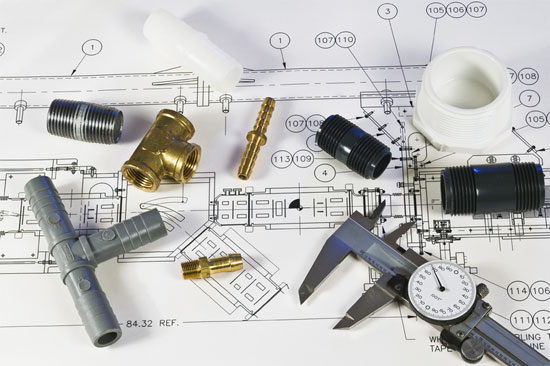
Private houses are heated by heating systems. They use a convenient and versatile way of delivering heat using a coolant. You can heat the coolant in different ways. Often, owners use several water heating devices.
Any heating scheme in a private house consists of components:
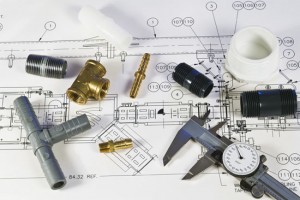
If you want to create heating of a private house with your own hands, the schemes are selected based on the possibilities. There are few options, there are only two of them:

It is difficult to determine which scheme of a private heating house is optimal, especially for a layman, so you should definitely consult a professional. Most heating circuit specialists are convinced that a two-pipe heating scheme for a private house is optimal. There is a misconception about lower costs for a one-pipe system.
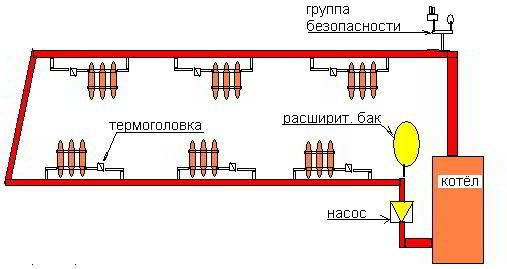 The opinion of many experts is the opposite - it is more expensive and it is more difficult to set up and adjust. The principle of its operation is the sequential movement of fluid through the radiators, which means that the temperature drops from battery to battery, so it is necessary to increase the power of the system. The main pipe is selected with a larger diameter. In addition, the mutual influence of heating devices on each other is very strong. This influence makes automatic control difficult.
The opinion of many experts is the opposite - it is more expensive and it is more difficult to set up and adjust. The principle of its operation is the sequential movement of fluid through the radiators, which means that the temperature drops from battery to battery, so it is necessary to increase the power of the system. The main pipe is selected with a larger diameter. In addition, the mutual influence of heating devices on each other is very strong. This influence makes automatic control difficult.
Where is the one-pipe heating scheme used?
 The heating of small houses is successfully provided by the Leningrad heating scheme, which has as many as four varieties. Among them, there are two varieties of one-pipe / two-pipe open systems and two kinds of one-pipe / two-pipe closed systems.
The heating of small houses is successfully provided by the Leningrad heating scheme, which has as many as four varieties. Among them, there are two varieties of one-pipe / two-pipe open systems and two kinds of one-pipe / two-pipe closed systems.
For a small house, a do-it-yourself heating system for a private house is chosen to be a one-pipe scheme, but with the number of batteries no more than 5, if there are more of them, then the last radiators do not warm up well. When starting the heating of a two-story house, the Leningradka scheme also works successfully, but the number of batteries is not more than six.
Single-pipe vertical heating systems work better.
The heated coolant of the same temperature is supplied to all vertical risers, and the batteries of the upper and lower floors are connected in series.
Features of two-pipe wiring of the circuit
The two-pipe system is presented in several varieties. They have a different scheme for connecting heating batteries in a private house, and the vector of movement of the coolant.
In small private houses, the following types of two-pipe heating systems are used: 
- dead end;
- passing;
- collector (beam).
Brief characteristics of two-pipe systems
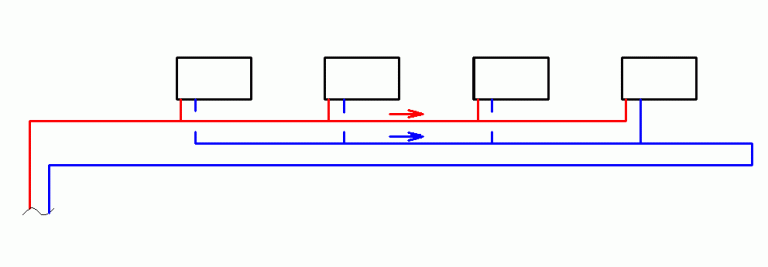 Dead-end system - the entire pipeline network consists of two arms (branches), one is supplied, and the other arm is the return of the coolant. The movement of water occurs in opposite directions.
Dead-end system - the entire pipeline network consists of two arms (branches), one is supplied, and the other arm is the return of the coolant. The movement of water occurs in opposite directions.
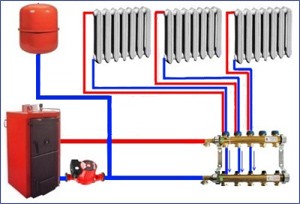 A passing two-pipe system - the reverse arm serves as a continuation of the supply arm (branch), that is, the system is looped. Such a scheme for connecting heating in a private house is deservedly popular.
A passing two-pipe system - the reverse arm serves as a continuation of the supply arm (branch), that is, the system is looped. Such a scheme for connecting heating in a private house is deservedly popular.
Collector is the most expensive wiring diagram for heating a private house due to the need to lay pipes to each battery, and their laying is made hidden.
Open "gravity" two-pipe system
 Consider the heating introduced in a private house with our own hands, a two-pipe open circuit is selected and an open tank is installed at the top point of the circuit. The head, which determines the speed of fluid movement in the "gravity" system, depends on the height of the tank rise. The main advantage of the two-pipe system is that the water flows to the radiators at the same temperature, and the clear division of the pipelines into supply and "return" facilitates the automation of control.
Consider the heating introduced in a private house with our own hands, a two-pipe open circuit is selected and an open tank is installed at the top point of the circuit. The head, which determines the speed of fluid movement in the "gravity" system, depends on the height of the tank rise. The main advantage of the two-pipe system is that the water flows to the radiators at the same temperature, and the clear division of the pipelines into supply and "return" facilitates the automation of control.
For the successful operation of the "gravity" system during installation, a slope of 3-5 mm / m is provided. Due to gravity, a heating system of any type can work, if the necessary conditions are created - the slope of the coolant supply lines for natural circulation. It should be borne in mind that the "gravity" system is capable of working only with an open expansion tank.
Closed two-pipe system
 Mounted in a private house, the scheme is selected closed, and its type depends on the number of storeys of the building. If the house is one-story, then two branches of the pipeline are laid - the supply and the "return", and already heating devices are connected to them in parallel.
Mounted in a private house, the scheme is selected closed, and its type depends on the number of storeys of the building. If the house is one-story, then two branches of the pipeline are laid - the supply and the "return", and already heating devices are connected to them in parallel.
And in order to mount the heating of a two-story private house with your own hands, the wiring diagrams must contain the required number of liquid supply branches. One branch of the collector must supply the batteries of the upper floor, the second branch supplies the batteries of the lower floor. The water that has given up its heat is returned to the boiler through the "return". A closed system must have a circulation pump to generate pressure.
Warm floor - uniform and comfortable heating
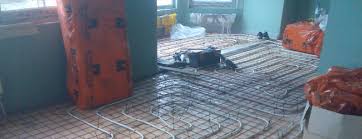 The schemes of heating systems for a private house are becoming popular - comfortable warm floors. The practical implementation of such a project consists in laying hundreds of meters of pipes under the screed, usually made of polypropylene, to assemble the heating circuit. The ends of the pipes open onto a distribution manifold. The liquid in the underfloor heating main is moved by a separate one.
The schemes of heating systems for a private house are becoming popular - comfortable warm floors. The practical implementation of such a project consists in laying hundreds of meters of pipes under the screed, usually made of polypropylene, to assemble the heating circuit. The ends of the pipes open onto a distribution manifold. The liquid in the underfloor heating main is moved by a separate one.
Heating system installation
 It is possible to positively solve the problem - how to make heating in a private house its scheme is given above, if you follow certain rules and sequence of work. Installation work begins with the installation and subsequent piping of the boiler. Gas boilers with a capacity of up to 60 kW are installed in the kitchen. All the rules for installing boilers are detailed in the instructions for them.
It is possible to positively solve the problem - how to make heating in a private house its scheme is given above, if you follow certain rules and sequence of work. Installation work begins with the installation and subsequent piping of the boiler. Gas boilers with a capacity of up to 60 kW are installed in the kitchen. All the rules for installing boilers are detailed in the instructions for them.
Heating boiler piping is the process of connecting the necessary equipment.
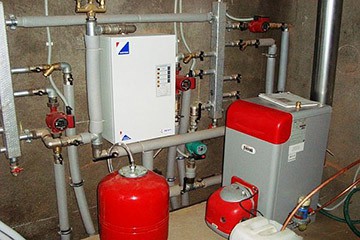 There are two ways to mount a heating circuit from gas-water (metal) pipes - by welding and using threaded connections. Of course, you can quickly create a system by welding, but it will turn out to be non-separable. By connecting the pipes of the system with threaded connections, you can easily change the configuration at any time or replace any section of the line. Particular attention, with any installation methods, requires a connection diagram for heating radiators in a private house, and it must be drawn and calculated in advance.
There are two ways to mount a heating circuit from gas-water (metal) pipes - by welding and using threaded connections. Of course, you can quickly create a system by welding, but it will turn out to be non-separable. By connecting the pipes of the system with threaded connections, you can easily change the configuration at any time or replace any section of the line. Particular attention, with any installation methods, requires a connection diagram for heating radiators in a private house, and it must be drawn and calculated in advance.
Dual-circuit heating system
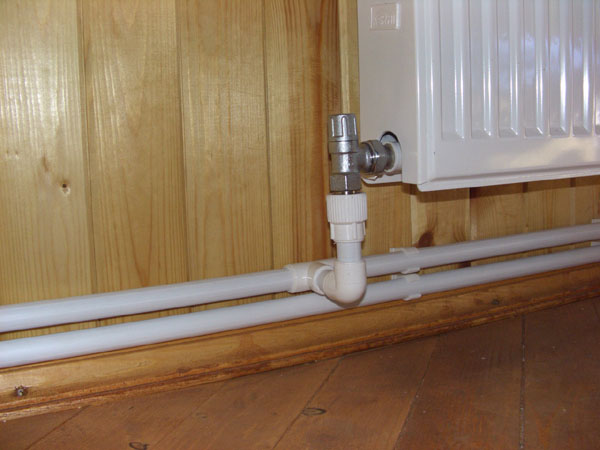 DHW (hot water supply) is created by a two-circuit heating system of a private house, its wiring diagram is drawn even before installation, and then mounted to the selected hot water supply point. Gas consumption, when using a two-circuit system, increases slightly. With intensive extraction of hot water, the consumption is 25% higher.
DHW (hot water supply) is created by a two-circuit heating system of a private house, its wiring diagram is drawn even before installation, and then mounted to the selected hot water supply point. Gas consumption, when using a two-circuit system, increases slightly. With intensive extraction of hot water, the consumption is 25% higher.
Features of the use of polypropylene pipes
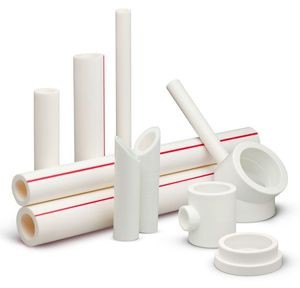 The implementation of a heating scheme in a private house made of polypropylene has many advantages. Polypropylene pipes are cheaper and lighter than metal pipes, they do not rust. Plastic pipes do not need painting, they look good and do not worsen the interior of the room. The procedure for creating a heating system from polypropylene pipes resembles an assembly from a designer. Pipes are quickly and efficiently connected using a welding unit.
The implementation of a heating scheme in a private house made of polypropylene has many advantages. Polypropylene pipes are cheaper and lighter than metal pipes, they do not rust. Plastic pipes do not need painting, they look good and do not worsen the interior of the room. The procedure for creating a heating system from polypropylene pipes resembles an assembly from a designer. Pipes are quickly and efficiently connected using a welding unit.
For the installation of polypropylene pipes, the following equipment, tools and materials are used:
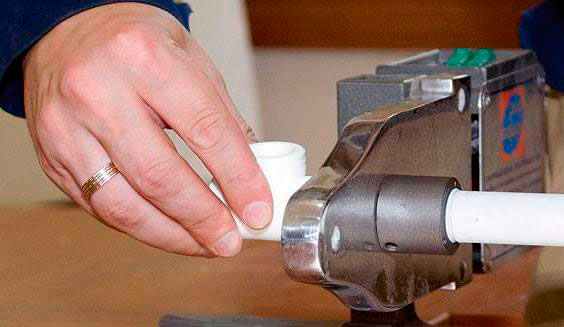
Note: the amount of materials, tools and components required is determined before installation, after drawing the heating circuit diagram. Couplings, ball valves and fittings are purchased depending on the type of boiler, the selected scheme and the size of the polypropylene pipe.
Water electric heating
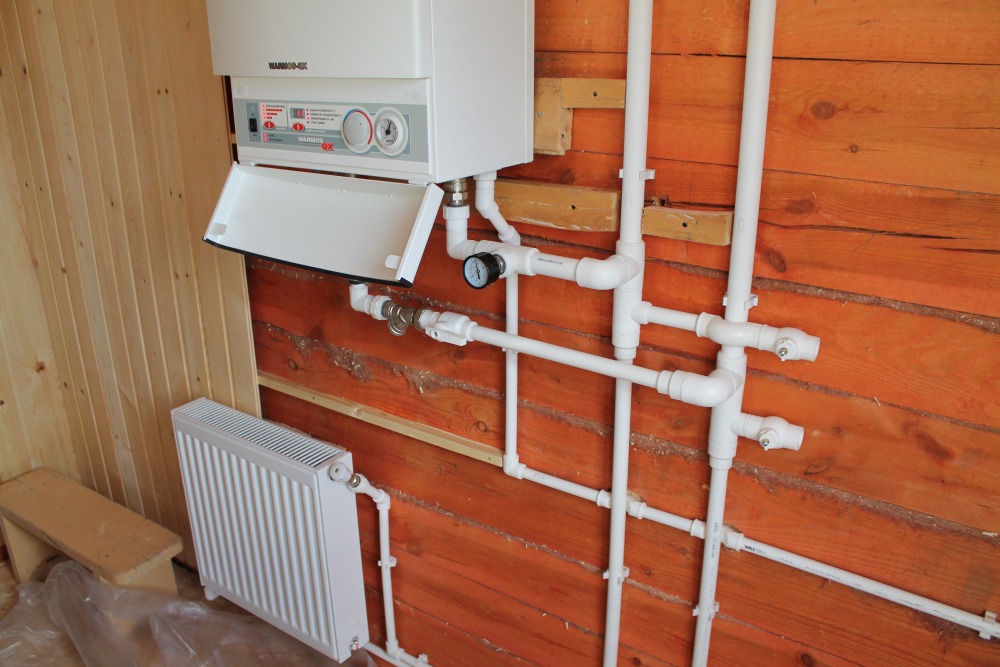 If you use electric heating of a private house with your own hands, the circuit connection diagrams are described above. An electric boiler can be designated as the main heat source or as a backup one if the house already has a heating source, for example, a gas boiler. An electric boiler consumes significant power, so the wiring cross-section must correspond to the current consumed.
If you use electric heating of a private house with your own hands, the circuit connection diagrams are described above. An electric boiler can be designated as the main heat source or as a backup one if the house already has a heating source, for example, a gas boiler. An electric boiler consumes significant power, so the wiring cross-section must correspond to the current consumed.
 It is not at all necessary to make reinforced wiring throughout the house, it is enough to lay a suitable cable from the meter to the boiler. Since an electric boiler is a device that heats water, then a closed system or a gravity heating system of a private house will work with it, the scheme is standard. The piping diagrams are no different from the diagrams described above.
It is not at all necessary to make reinforced wiring throughout the house, it is enough to lay a suitable cable from the meter to the boiler. Since an electric boiler is a device that heats water, then a closed system or a gravity heating system of a private house will work with it, the scheme is standard. The piping diagrams are no different from the diagrams described above.
Three types of electric boilers are used to create electric heating:
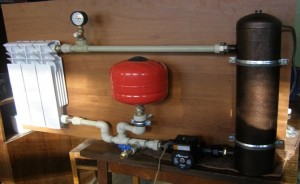
- electrode;
- induction;
- boiler using heating elements.
It is believed that the heating element boiler, which has passed the test of time, is more reliable. It is advisable to pour softened water into the system so that there is less scale on the heating elements. Electric boilers have high efficiency, but the main obstacle to their widespread use is the growing price of electricity.



